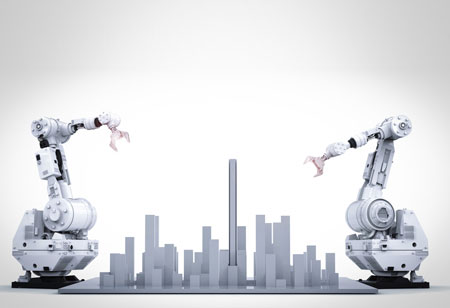THANK YOU FOR SUBSCRIBING
4 Trends Robotics Inflicted By Advanced Robotics in Construction Industry
Enhanced efficiency, collaborative features, and AI can assist the betterment of construction projects and improve the quality of manual processes while addressing the labor shortage.

By
Apac CIOOutlook | Tuesday, October 15, 2019
Stay ahead of the industry with exclusive feature stories on the top companies, expert insights and the latest news delivered straight to your inbox. Subscribe today.
Enhanced efficiency, collaborative features, and AI can assist the betterment of construction projects and improve the quality of manual processes while addressing the labor shortage.
Fremont, CA: The efficiency and productivity of the construction projects are recognized to be lacking in several areas and is still yet to find its true potential. From 2005, the industry has seen an average annual growth in terms of digitization and productivity of 4 percent, lowest among industries as recorded by Mckinsey report. Nearly 200,000 construction jobs were vacant by February 2017, reveals the U.S. Bureau of Labor Statistics. There has been negligent growth and a huge demand for smart working systems. By 2018, the industry was open for disruption buy robotics.
Many robotics-based technologies have already taken its place, and many more are in development stages to shape the future of the construction industry. The advanced robotics can help replace and enhance the existing processes, transforming them into an efficient and precise task.
Even though robots do not play an essential role at present in the construction industry, it is expected to take charge of both residential and commercial construction projects sooner than later and result in an incredibly transformative experience for the industry.
Here are four important ways in which modern and advanced robotics will shed some light on in the construction industry:
1. Increased Efficiency and Low Operation Costs:
The implementation of robotics and automation systems in construction processes have equal advantages and limitations, sort of a catch-22 situation. The capital costs are high, but they get the work done efficiently in comparison with manual labor. On the flip side, the human aspect of the operation is plucked out, leaving the craftsmanship value and flexibility to any instances out of the question.
Collaborative robots or cobots are solutions to keep alchemy live among humans and machines in the construction industry. These robots are programmed to work alongside their human counterparts instead of completely replacing them.
Check out: Top Construction Technology Companies
Cobots augment and improve productivity by executing tasks that are repetitive for the employees. The cobots can significantly reduce the number of labors required of the projects. As the work-related relationships are altered with a cobot colleague, this phenomenon is set to alter the way humans interact with the world and each other in several ways. This alteration can result in a dynamic shift within the construction industry and administrative teams, forcing people to become flexible for new roles and adapt.
2. Heightened Efficiency on Iterative Tasks:
Human workers have various emotional and circumstantial obligations to deal with, whereas robots do not. Family-related or personal inadequacies can compromise the quality of their work. Robots, on the other hand, can operate continuously for an extended period without any degradation in the rate and quality. Although its efficiency depends on its maintenance and parts failure, if kept monitored and proactively repaired, it can perform iterative tasks swiftly. Since robots and automated systems offer a much high level of precision and efficiency when compared with human counterparts, it is worth implementing. For example, a construction masonry robot can lay up to 350 bricks per hour in a pre-defined course. This is multiple times faster than the masons.
3. Customized Development:
In a conventional construction project, there are innumerable steps, from planning to construction or assemble processes. Since ages, the steps have been the same with few changes. With the development of 3D printing robots, the current wheel of the conventional routine will be shattered. The manufacture of additives will create unprecedented scaling opportunities for custom and on-demand projects. The need for transporting heavy or large construction materials can be avoided if they are pre-fabricated on-site with 3D printing robots. Nuanced project changes and complete cutdown in overhead costs are apparent with the use of 3D printing technology. Customization in every detail can be conducted without much expenditure and wastage.
4. Wearables, Augmentation, and Automation:
Robotics are utilized to augment various capabilities. Some enterprises are already working on an exoskeleton that will enhance the mobility of the person wearing it. This robot makes the workers stronger and avoids numerous work-related injuries.
The exoskeleton will assist in the elimination of excessive stress and damage that takes place to a body during physical labor. The robotic wearables are developed to provide superhuman strength to the workers by providing them more stamina through modern robotics and biotic.
In addition to augmentation of the abilities, some suits are also designed to automate specific movements and projects involuntarily.
Check This Out: Top APAC Robotics Solution Companies
See Also: Top Robotics Tech Companies





